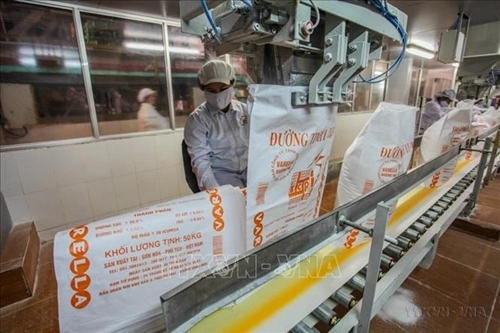According to experts, trade cooperation is an important pillar in the Vietnam-India relations with impressive achievements.
A representative of the Ministry of Industry and Trade (MoIT) said that India is currently Vietnam's leading economic partner in the South Asian region and the 8th largest trading partner in the world. Notably, trade with India accounts for about 80% of Vietnam's total trade turnover with South Asian countries, which has grown significantly.
    |
 |
|
A refined sugar product packaging line at the factory of Indian-invested KCP Vietnam Industries Limited in Son Hoa and Dong Xuan districts of Phu Yen province |
The annual growth of Vietnam-India trade turnover expanded 17.3% in the 2011-2016 period and 12% in the 2017-2023 period. In the first half of 2024, the figure rose by 2% year on year to 7.18 billion USD.
Vietnam's main exports to India include computers and electronics, mobile phones and accessories, machinery and equipment, steel and other metals, chemicals, footwear, garments, rubber, and wood products. Meanwhile, Vietnam imports from India technical products, agricultural products, chemicals and pharmaceuticals, electronics, minerals, cotton and textiles, and plastics.
India consumed 50% of Vietnam’s total star anise export volume. In the 2022-2023 fiscal year, Vietnam supplied 32,650 tons of cinnamon to India, accounting for 80% of India’s total imports of this product.
India is Vietnam's fourth largest pepper market, consuming 6,813 tons worth 28 million USD, up 46.5% in volume and 90.6% in value.
In particular, with a large population, India has a huge market demand for cinnamon, star anise, and medicinal herbs.
According to the MoIT, trade between the two countries has yet to match the potential of the two sides.
The International Monetary Fund (IMF) forecast that Vietnam's GDP will expand nearly 6% in 2024. The good economic growth and macroeconomic stability are extremely important factors in attracting investment, facilitating production and business activities of Vietnamese and Indian enterprises.
In addition, Vietnam and India have launched direct flights between Hanoi, Ho Chi Minh City, Da Nang city, and many Indian cities such as New Delhi and Mumbai with a frequency of nearly 50 flights per week, making it easier for people and businesses of Vietnam and India to travel to each other’s country.
However, the exports to India currently account for only 2.1% of Vietnam’s total exports to the world, while imports from India make up only 1.97% of the Southeast Asian country's total.
The MoIT advised businesses to increase the exports of processed fruits, fresh fruits, tea coffee, spices, cereals and nuts, and tra fish to India, and recommended Indian firms to supply more raw materials for textiles, footwear, components and spare parts for the mobile phone, electronics and mechanical manufacturing industries of Vietnam.
Nguyen Thi Thu Hien, Vice Chairwoman of the Indian Importers Chambers of Commerce and Industry (IICCI), held that in order to conquer the giant market of India, businesses should pay more attention to building trust and a long-term positive relationship with Indian partners.
Source: VNA